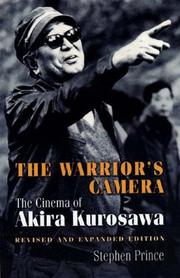| Listing 1 - 2 of 2 |
Sort by
|
Book
ISBN: 1476635692 9781476635699 9781476670133 1476670137 Year: 2019 Publisher: Jefferson, North Carolina
Abstract | Keywords | Export | Availability | Bookmark
 Loading...
Loading...Choose an application
- Reference Manager
- EndNote
- RefWorks (Direct export to RefWorks)
"Considered one of the finest performers in world cinema, Japanese actor Takashi Shimura (1905-1982) appeared in more than 300 stage, film and television roles during his five-decade career. This is the first complete English-language account of Shimura's work. In addition to historical and critical coverage of Shimura's life and career, it includes an extensive filmography"--
Motion pictures --- Motion picture actors and actresses --- History --- Shimura, Takashi,

ISBN: 0691031606 0691008590 0691214182 Year: 1991 Publisher: Princeton Princeton university press
Abstract | Keywords | Export | Availability | Bookmark
 Loading...
Loading...Choose an application
- Reference Manager
- EndNote
- RefWorks (Direct export to RefWorks)
The Japanese film director Akira Kurosawa, who died at the age of 88, has been internationally acclaimed as a giant of world cinema. Rashomon, which won both the Venice Film Festival's grand prize and an Academy Award for best foreign-language film, helped ignite Western interest in the Japanese cinema. Seven Samurai and Yojimbo remain enormously popular both in Japan and abroad. In this newly revised and expanded edition of his study of Kurosawa's films, Stephen Prince provides two new chapters that examine Kurosawa's remaining films, placing him in the context of cinema history. Prince also discusses how Kurosawa furnished a template for some well-known Hollywood directors, including Martin Scorsese, Steven Spielberg, and George Lucas. Providing a new and comprehensive look at this master filmmaker, The Warrior's Camera probes the complex visual structure of Kurosawa's work. The book shows how Kurosawa attempted to symbolize on film a course of national development for post-war Japan, and it traces the ways that he tied his social visions to a dynamic system of visual and narrative forms. The author analyzes Kurosawa's entire career and places the films in context by drawing on the director's autobiography--a fascinating work that presents Kurosawa as a Kurosawa character and the story of his life as the kind of spiritual odyssey witnessed so often in his films. After examining the development of Kurosawa's visual style in his early work, The Warrior's Camera explains how he used this style in subsequent films to forge a politically committed model of filmmaking. It then demonstrates how the collapse of Kurosawa's efforts to participate as a filmmaker in the tasks of social reconstruction led to the very different cinematic style evident in his most recent films, works of pessimism that view the world as resistant to change.
791.44
---
J6839
---
J6800.80
---
Filmproductie. Filmindustrie
---
Japan: Media arts and entertainment -- cinema
---
Japan: Performing and media arts -- history -- Gendai (1926- ), Shōwa period, 20th century
---
Kurosawa, Akira
---
-Criticism and interpretation
---
791.44 Filmproductie. Filmindustrie
---
Kurosawa, Akira,
---
Heize, Ming,
---
Kurosava, Akira,
---
Kurōcāvā, Akirā,
---
黑沢明,
---
黑澤明,
---
黒沢明,
---
黒澤明,
---
Kūrūsāvā, Ākīrā,
---
کوروساوا، آکيرا,
---
Criticism and interpretation.
---
黑沢明
---
Film.
---
Cine
---
Producción y dirección
---
Kurosawa, Akira.
---
Crítica e interpretación.
---
Bibel
---
Japan.
---
American Western.
---
Ashikaga era.
---
Bakhtin, Mikhail.
---
Buddhism.
---
Chaplin, Charles.
---
Dersu Uzala.
---
Dodeskaden.
---
Drunken Angel.
---
Eisenstein, Sergei.
---
Godard, Jean-Luc.
---
Gorky, Maxim.
---
Hayasaka Fumio.
---
Hojoki.
---
Ikiru.
---
Kagemusha.
---
Leone, Sergio.
---
Madadayo.
---
Marxism.
---
Nakadai Tatsuya.
---
Neo-Confucianism.
---
Noh theater.
---
Oda Nobunaga.
---
Oguni Hideo.
---
Peckinpah, Sam.
---
Ran.
---
Red Beard.
---
Sengoku period.
---
Shimura Takashi.
---
Takeda Shingen.
---
Tokugawa period.
---
haiku.
---
individualism.
---
karma.
---
satori.
---
Philemonbrief
---
<
| Listing 1 - 2 of 2 |
Sort by
|

 Search
Search Feedback
Feedback About UniCat
About UniCat  Help
Help News
News